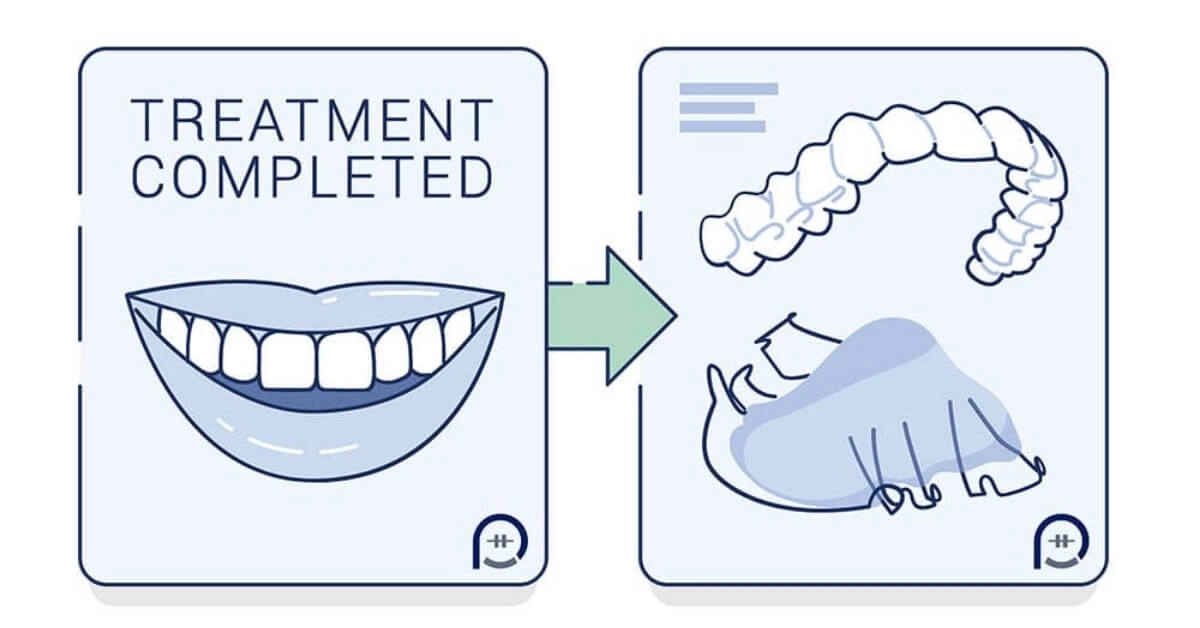Learn the details of what matter everyday
Table of contents
- What is an orthodontic retainer?
- What do dental retainers do after braces or Invisalign do?
- Why do I need retainers after braces or aligners?
- Could I wear an orthodontic retainer without braces?
- Will I wear my retainer for the rest of my life?
- There are three primary reasons that your teeth move after a completed orthodontic treatment:
- Should I wear my retainer all the time?
- How Are Clear Plastic Retainers Fitted After Braces?
- What happens if you don’t wear retainers after braces
- What is a custom clear plastic retainer?
- Teeth retainer vs mouthguards
- How do you clean orthodontic retainers?
- What are the different orthodontic retainer types?
- How do I get an orthodontic retainer?
- Can my retainer fix minor changes in my teeth?
- How much does an orthodontic retainer cost?
- Can I order an orthodontic retainer online without visiting a dental clinic?
Orthodontic Retainers FAQ | retainer after braces or clear aligners (like Invisalign)
The most frequently asked questions that I get circle around the retention phase of orthodontic treatment — it’s the part where you’re done with wearing your aligners or braces and are moving on to the next phase of the treatment.
Removable or permanent retainers require lifetime maintenance to avoid teeth shifting and subtle changes or major relapse.
The retention phase is crucial to hold your smile and avoid the risk of more rounds of orthodontic care. The retainer wear is a commitment for the rest of your life. To avoid moving your straight teeth to the old positions. I noticed the same pattern of questions whether my patient is a child, teen, or an adult.
What is an orthodontic retainer?
A retainer after braces are used to hold teeth in place after we move them.
Retainers are most often prescribed after the completion of orthodontic treatment when brackets are removed or aligner treatment was completed. A metal wire bonded on the back of your teeth was a traditional retention protocol. Things has changed and we moved to clear plastic retainers.
A retainer can also be worn to prevent unwanted normal tooth movement that comes with aging independent of having braces.
Retainers are importnat to avoid wearing braces again and preventing your straight teeth to go to their original position.
What do dental retainers do after braces or Invisalign do?
The three main reasons to wear an orthodontic retainer are:
- To hold your teeth and prevent relapse after orthodontic treatment.
- The retainer framework can be used to replace missing teeth with one or more fake teeth to have an esthetic perfect smile.
- Hold your teeth to avoid physiological tooth movement associated with aging.
Why do I need retainers after braces or aligners?
The short answer is to prevent your teeth from going back their original position. After teeth alignment the teeth won’t go completely back rather you will have some relapse of increase in your overbite.
Retention phase of the orthodontic treatment starts immediately after removal of orthodontic appliances - braces or Invisalign. The idea of the retention phase goes back to 1945, and it has proven to keep your hard-earned results of treatment in good shape.
Could I wear an orthodontic retainer without braces?
The simple answer is YES.
Some people use a retainer without going through orthodontic treatment to avoid unwanted tooth movement. Talk to your dentist or see an orthodontist to get more information on possible options for your particular case.
Will I wear my retainer for the rest of my life?
One of the most common questions is, “how long do I have to wear my retainer?” To answer that, first let’s talk about several reasons why retainers are important.
The main goal of the retention phase is to hold your teeth in the optimal functional and esthetic position. If your retainer no longer fits it means that you have not worn it for the appropriate length of time after having your braces or Invisalign treatment completed.
There are three primary reasons that your teeth move after a completed orthodontic treatment:
1. Gum and bone tissues supporting the teeth remodel in response to tooth movement.
These tissues — including ligaments around the gum — require an adequate time to fully restructure in their new shape and position. Retainers hold teeth in their new optimal position and provide enough time for the remodeled supporting tissues to mature.
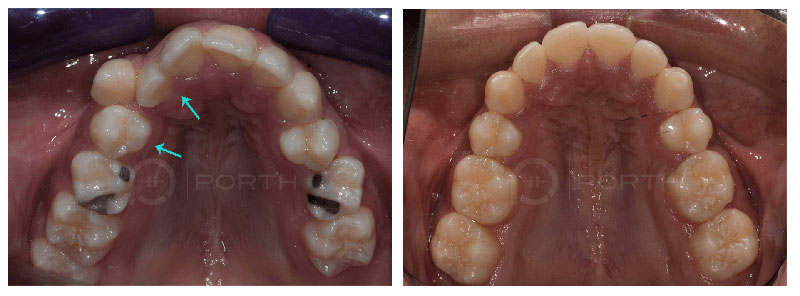
2. Typical growth and aging result in changes in the bone tissue supporting the teeth resulting unfavorable tooth movements.
But the good news is that wearing your retainer is a highly effective way to prevent crowding of the lower front teeth. Many people intuitively assume that once their wisdom teeth come in, it will cause crowding of the lower front teeth, but research studies rejected this idea. Remodeling of the front part of lower jaw bone as a part of aging is often the main reason for the lower teeth crowding.
In some rare scenarios, the late growth of the lower jaw changes the bite after the already completed orthodontic treatment. Wearing retainers is not efficient in preventing unwanted skeletal growth. In other words, a successfully treated bite could turn into an underbite if the lower jaw keeps growing.
3. Moving teeth into an unstable position during an orthodontic treatment causes relapse as well.
Retainers would only hold teeth in this position if they are worn for life time. Teeth are mostly stable as long as they are in their bony housing. This notion is very critical in patients with severe crowding who were treated without removing teeth. This is a fundamental concept justifying removal of healthy teeth in patients with severe crowding.
Should I wear my retainer all the time?
The instructions for wearing a retainer vary based on whether you’re prescribed limited retention or permanent retention.
Retainer wear protocol also depends on the retention philosophy that your treating orthodontist follows. It is often recommended to start with full-time wear then switch to night time wear.
Do not neglect these instructions until your retainer no longer fits.
How Are Clear Plastic Retainers Fitted After Braces?
Your clear plastic retainer or acrylic removable retainer should fit snugly when you first wear them after your braces are removed. Ideally, your teeth shouldn’t experience any pain or discomfort with a properly fitting retainer.
Some orthodontists pair clear retainers with a permanent wire retainer, especially on the lower teeth. While this combination can provide extra stability, it may make flossing around the wire retainer challenging, leading to tartar buildup near the lower teeth.
Maintaining proper care of your clear retainer is crucial to ensure long-term oral health. Clean your clear retainer with a gentle toothpaste or anti-bacterial dish soap. Avoid using hot water, as it can warp the plastic, causing the retainer to lose its fit. Neglecting to clean your clear retainer can result in oral hygiene issues, such as gum inflammation.
What happens if you don’t wear retainers after braces
After your braces are removed, your need to wear retainers to maintain the new position of your teeth. You might need retreatment if you don’t wear retainers after braces or Invisalign. For adult patients that they did not wear retainers for a while and their teeth shift, we offer exceptional clear aligner therapy at Porth to get them back on track.
What is a custom clear plastic retainer?
Custom clear retainers are essential for maintaining a beautiful smile and oral health after orthodontic treatment. Clear retainers are crafted from high-quality, often BPA-free retainer material, ensuring safety and durability.
Online order clear retainers begins with an impression kit, which includes putty and impression trays to create a precise impression of your teeth. The impression kit allows you to make molds of your upper teeth for the upper retainer and your lower teeth for the lower retainer, hoping for a perfect fit. Theses retainers are offered with the notion of a simple checkout process often at a sale price saving from the regular price. You will be also promised an easily reorder or purchase additional products like retainer cases – even a night guard at a fraction of the cost. Whether you need a single upper & lower retainer or additional retainers. This process seems simple but taking an accurate impression is a complex process. The online custom clear retainers sounds like a great idea but they could actually create major issues if they are not made accurately.
Teeth retainer vs mouthguards
Custom made clear retainers and sport mouth guards are made similarly but their functions are different. Clear retainers can help protecting your teeth from teeth grinding but the sport mouthguards guard your teeth from impact.
How do you clean orthodontic retainers?
Brushing your retainers with some dish soap (preferably anti-bacterial) on a toothbrush every day should keep them perfectly clean. A few other products are available on the market for easy cleaning. Make sure to check with your orthodontist about your options. Remember that growing bacteria on your retainer is what creates bad odor. Keep it clean and it won’t smell.
What are the different orthodontic retainer types?
Removable Retainers
Clear retainer is a clear overlay plastic tray that covers all the teeth. This retainer is also known as an invisible or Essix retainer. It’s esthetically pleasing making this retainer a popular choice for most patients. Align technology provides a clear retainer called Vivera to patients treated with braces or the Invisalign appliance.
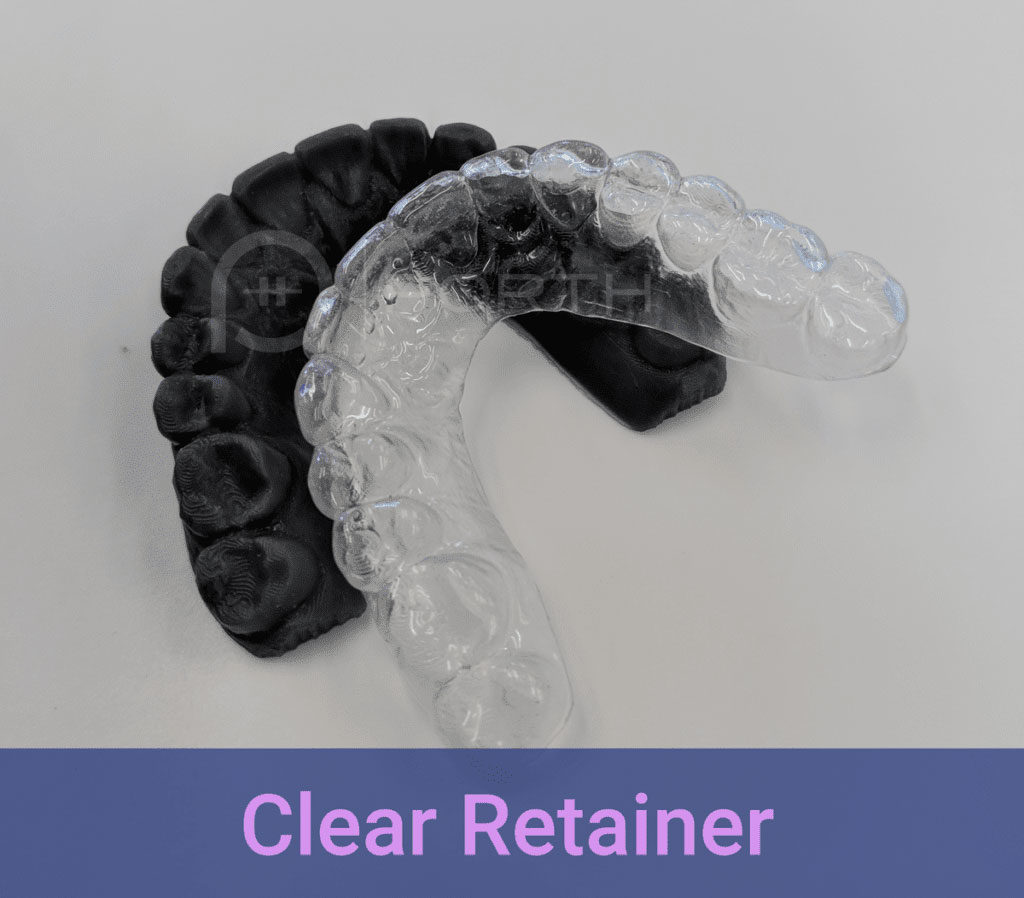
Hawley retainer is a common type of retainer used by orthodontists. The parts of this retainer include an acrylic portion, which covers the palate, and the bow, which embraces the front teeth. There are many variations of Hawley retainers fabricated by labs.
Hawley retainer with a ClearBow is a good cosmetic option for children, teenagers and adults who are concerned with the esthetic.
Wrap around retainer is similar to a Hawley retainer. The wire wraps around the teeth and the acrylic part uses the soft tissue as support.
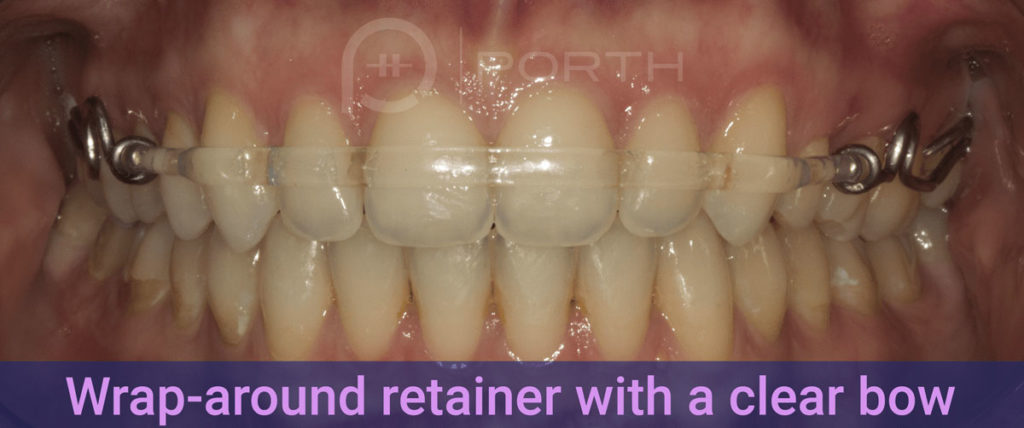
Retainer with spring is one of the retainers with acrylic framework that has a wire with a spring. The spring is often added to a retainer for minor tooth movements either after an orthodontic treatment (to fine-tune the bite) or instead of an orthodontic braces treatment for very minor tooth movements.
Some benefits of wearing the removable retainers listed above are:
- They make it easier to clean your teeth since you can easily remove them.
- You don’t need to wear it all the time except the first few weeks after your treatment is completed. After a consultation with your orthodontist, you might switch to part-time wear.
- You could have multiple backup sets.
The following are cons of removable retainers:
- They only work if you regularly wear them. Most of orthodontic relapses happen strictly because of not wearing retainers at all.
- It is easy to lose these kinds of retainers. But an easy way to remember to put them away is the “NOT ON YOUR FACE, IT IS IN THE CASE” principle — always keep them in the orthodontic retainer box when you’re not wearing them.
Fixed Wire Retainers (Bonded Retainer)
Fixed retainers are usually permanent retainers or an orthodontic lingual retainer wire. A fixed retainer is a bonded wire that is glued on the inside (lingual) of the teeth and sometimes the outside of the back teeth. Examples of fixed retainers include braided wires, goldflex wire, straight wire, or prefabricated fixed retainers.
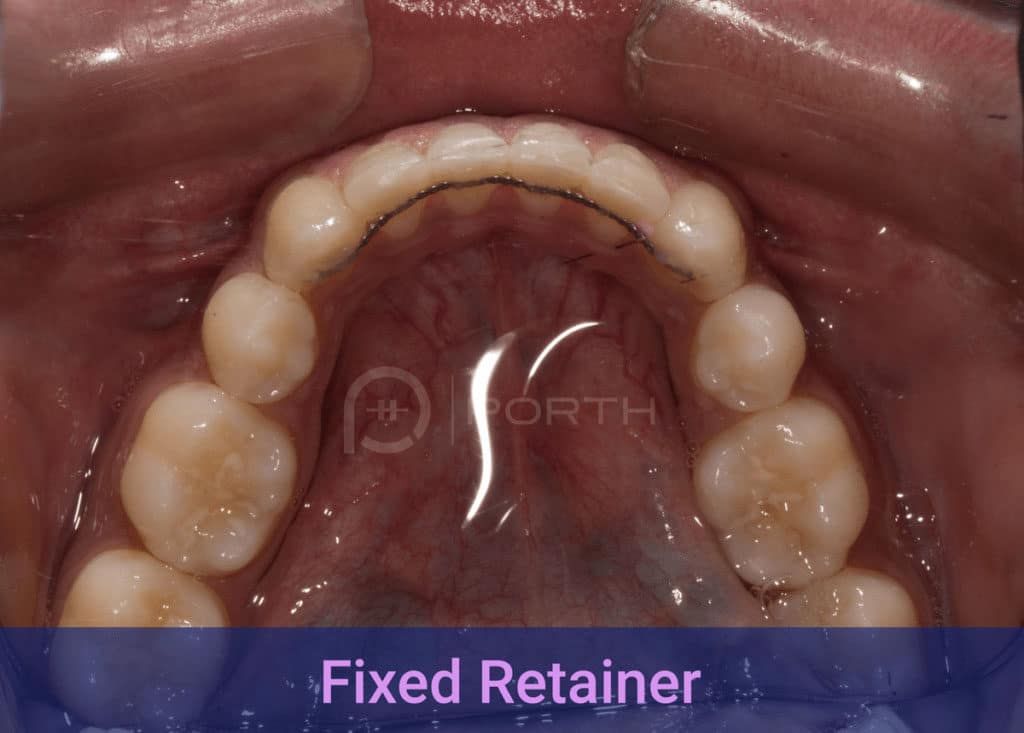
The main advantage of these types of retainers is that they don’t need any compliance at all.
However, there are some disadvantages of fixed orthodontic retainers:
- They make it hard to clean between the teeth that are connected with the orthodontic lingual retainer wire.
- Your teeth could potentially move if you bite on the wire and deform it.
- Lingual retainer wire, especially on lower anterior teeth, could lead to gum recession and bone loss if it is not cleaned properly and regularly.
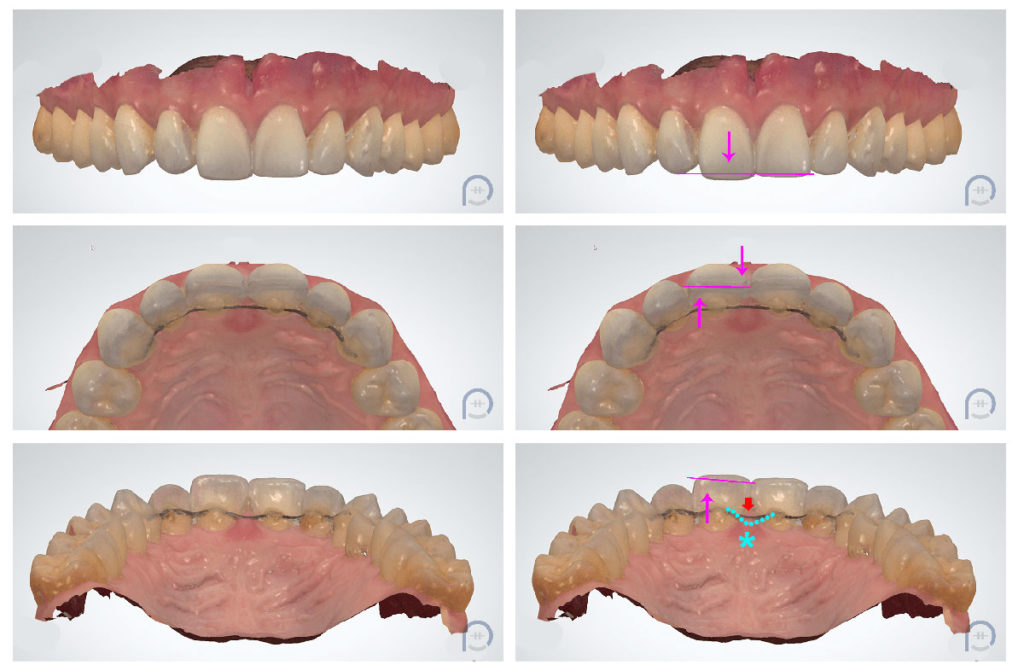
Combination retainers
Some orthodontists prefer to have a fixed retainer wire combined with a removable, often clear, retainers.
What is the best types of orthodontic retainer?
Orthodontists ofte recommend different types of retainers. The best retainer for you is the one prescribed by your orthodontist for your specific goals, independent of its design. Several factors define the best kind of retainer for each individual:
- Your lifestyle.
- The amount of tooth movement during your orthodontic treatment.
- Your reasons for wearing a retainer - holding your teeth or allowing them to settle.
How often should I have to wear my retainers?
Retention protocols (or instructions) vary between limited, moderate, and permanent retention. One of these options is often suggested at the end of treatment based on the retention philosophy that the treating orthodontist follows.
How do I get an orthodontic retainer?
Orthodontists offer both braces and retainers. The first set of retainers is often included in the orthodontic treatment. Some people that never had braces like to wear a retainer to avoid crowding. You can consult with an orthodontist for a retainer if you are looking to get one for preventative purposes.
What does it mean when my orthodontist tightens my retainer?
Retainers that have wires could be tightened by adjusting the wires. A good example of that is a Hawley retainer. The front bow of a Hawley retainer deforms after 1–2 months of wear, especially if you remove the retainer by pulling down the bow, and it needs to be adjusted and tightened.
How do I repair a broken ortho retainer?
That depends on the type of the retainer that you have. An orthodontic office would send your retainer to a lab for repair if the broken part is repairable. For example, a small crack in an acrylic part is repairable, but a cracked clear retainer is not. You can ask for a new retainer to be made for you. Make sure you ask about all the options available when you decide to get a brand new retainer.
Can my retainer fix minor changes in my teeth?
More often than not, yes. For example, If you did not wear your retainer enough and your teeth slightly shifted, your retainer could be adjusted to fix that. Retainers can be used for minor tooth movements. Unfortunately, to fix more major shifts in teeth, retreatment can be the only option. Ask your orthodontist about the available options for retreatment.
How much does an orthodontic retainer cost?
The cost of an orthodontic retainer depends on the type of the retainer and other services that the clinic provides with the retainer purchase. The average cost of an orthodontic retainer is $250. Some of those included services could be retainer check visits, replacement retainers, and a spare retainer. The cost of orthodontic retainers may range from $0 to $1,000. At Porth, we provide multiple options of retainer packages. Cost of braces could also cover one or more retainers.
Can I order an orthodontic retainer online without visiting a dental clinic?
Yes! You can order pretty much anything online these days. Nonetheless, I strongly discourage this option without visiting a dental or orthodontic clinic.
A retainer can unfavorably move your teeth if it doesn’t properly fit. Consult with your orthodontist in person to get the retainer that best fits YOU for YOUR needs.
Book a free consultation to learn more about PORTH custom clear retainer.
Disclaimer: This blog post providers information and merely reflects Dr. Rooz Khosravi’s expert opinion. You should consult with a dentist or an orthodontist prior to following any advice suggested here.
All the contents of this blog is intellectual property that is owned, copyrighted and reserved by or to Porth (personalized orthodontics). This content is protected under copyright or trademark laws based on the Digital Millennium Copyright Act. Reproducing, duplicating, copying, or otherwise exploiting any of the contents of this blog without the permission of Porth is strictly prohibited.
